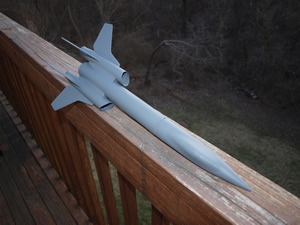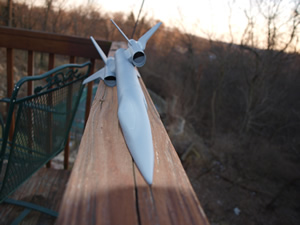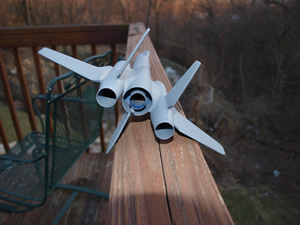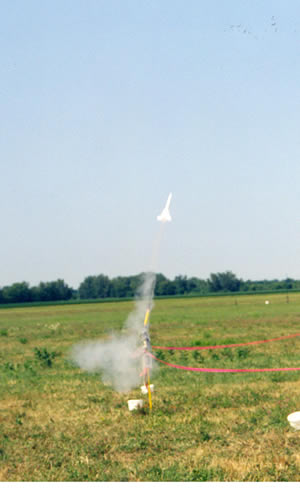| Construction Rating: | starstarstarstarstar_border |
| Flight Rating: | starstarstarstarstar_border |
| Overall Rating: | starstarstarstarstar_border |
| Published: | 2010-02-01 |
| Manufacturer: | Estes  |

Brief:
"Futuristic fighter that operates in low orbit hunting satellites and other spacecraft."
I describe it as one of the rockets my wife bought me in 1994 at a closing sale of an Arlington, Texas hobby shop. This one, the Super Vega and the F-22 Air Superiority Fighter were the three that most intrigued me. The F-22 ASF has never flown, and another rocket, the Hornet, remains unbuilt to this day. I particularly liked the Interceptor look of this one, and the brilliantly simple way that the pods went together.
Construction:
Parts:
- 9" BT-55IJ main body tube
- 4" BT-50S large engine tube (2)
- 2.75" BT-20J engine tube
- 1.5" BT-20AE small engine tube (2)
- PNC-55IR nose cone
- 18mm engine hook
- 18mm engine block
- 2 CR-2055 centering rings
- Too little shock cord
- 12' parachute kit
- 3/32" balsa fin stock
- cardstock pieces
- launch lug
- 2 CR-250 centering rings
- 2 BT-50 tube couplers
- decal
Having been out of the game for almost fifteen years, I was more than a little intimidated by the parts and instructions when I opened the Greyhawk box. I almost packed it in, but then remembered that I was the guy who'd built the Andromeda, Alien Invader AND skill level 5 Mercury Redstone in high school. Nerves forgotten, I tore into the project. Turned out to be no different than I remembered, and the project progressed quickly. (To a Nickelodeon soundtrack thanks to the kids. I always think of Rug Rats when I see this bird.)


Despite the looks, construction of the Greyhawk wasn't any different than a typical rocket, but some of the details were worth pointing out. As I mentioned earlier, the engine pods had to be constructed out of two different sizes of body tubes, centering rings, tube couplers and cardstock. This filled me with trepidation, but I found that actually reading the directions for a change made all the difference in the world. Even with my toddler daughter in the room with me occasionally supervising, (luckily she mostly just wanted to point and ask "dat", then go back to her dollhouse,) I managed to get all the parts together in the manner intended, and was rewarded with a very cool looking bird. It's a very well thought out design and the pod details go well with the fighter nose cone. The finished Greyhawk is interesting in that it's one of the few rockets still flyable in my fleet from the days of the traditional folded shock cord mount and no sanding sealer.
Finishing:
I was a little disappointed in the paint and decal scheme suggested and as a result the Greyhawk has gone through
several repaints over the years. It's now quite bulky and despite the lack of any sealer, the fins have a sealed look
to them and the tube spirals are only slightly noticeable. I think that a final repaint of dark blue metallic is in the
future, with the Blue Angels decal scheme that I always thought would have been perfect for this bird.
Construction Rating: 4 out of 5
Flight:
It was a bit too cold to take the kids out launching when I finished the Greyhawk, and it eventually went from
the family room to the dreaded storage room along with the Super Vega and F-22 Air Superiority Fighter. When we finally
got around to flying a year and a half later, all three of the rockets had been damaged to some extent, so we made do
with an Estes Bail-Out and Manta that my son had received the previous Christmas. By the time I got a chance to fly the
Greyhawk, it was April of 2001. Repaired and painted white over the years, the Greyhawk was one of several rockets that
I took to fly at a family launch on Good Friday (aka - Good Fly-Day) launch on the front lawn of Big Bone Lick State
Park. Despite the large area, I went conservative on the engine choice and used a B6-4, probably because of the windy
conditions. The flight was perfect, if a little low for conditions, and recovered at the edge of the field. I then
learned a lesson about letting gangs of young kids run after rockets. The Greyhawk survived the flight fine, but lost a
fin to the stampede of little feet.
After several more B flights, I finally got a chance to stretch the Greyhawk out on a C6-7 at NARAM 43 in Geneseo, NY. The field was huge and the winds seemed light on the field. Overhead things were obviously different, because the higher the Greyhawk went, the more it windcocked. The seven second ejection was perfect for the conditions, as the charge fired just as the rocket stopped forward motion. Then the drift began. It came back across the pads riding a thermal and rode it back into an adjacent cornfield. I'd heard horror stories about the cornfield, but at that point in my BARdom, I didn't have enough rockets that I could afford to give up on one. Despite having only a vague idea where the rocket landed, I managed to walk right up to where it hung on a stalk. On the way out I even managed to find another rocket that I took to the lost and found.
The third flight of note was on a C5-3, which I was surprised to find as a recommended motor. This one left the pad with true authority, but the ejection charge was way early. As a result, the chute lines fouled in the fins and the rocket did a free fall into the parking lot. Damage was limited to a couple of broken fins. After I fixed the damage, I decided to go with a Navy blue paint scheme that I hoped to find a set of Blue Angels decals for. The blue crazed badly and the Greyhawk was put on a shelf to gather dust until I got interested again in it in 2009. Oddly enough, my flight log entries seemed surprised that this rocket performed as well as it did. Fifteen years down the road I look at it and can't imagine it NOT being a good performer. Strange.
Recovery:
As I said earlier, this was one of the rockets that I built just like I'd built them in my youth, with the parts
in the package and nothing else. The typical Estes folded shock cord mount anchors a shock cord that's too small by at
least its length. (Evidenced by the two gashes in the forward body tube and the extra piece of shock cord that I later
tied onto the original.) The rocket still has the original chute with a spill hole, holding together fine after quite
some time, but undoubtedly ready to be swapped out for a small nylon one.
Flight Rating: 4 out of 5
Summary:
Pro: Great looks and decent performance on 18mm engines. Ease with which it builds to a great looking rocket.
Cardstock pieces for added details and strength.
Con: Uninspired paint and decal scheme. C5-3 engine being listed as one of the motor choices.
Overall Rating: 4 out of 5
 |
 |